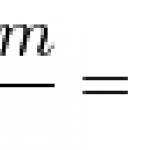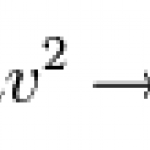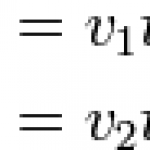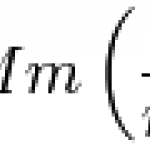Intro Physics
A reader emailed me a fun question from a physics exam he took, along these lines:
A car driver going at some speed v suddenly finds a wide wall at a distance r. Should he apply brakes or turn the car in a circle of radius r to avoid hitting the wall?
My first thought was that surely the question wasn't doable without more information, but it turns out that we do have enough to give a straightforward answer. Let's take the "turns in a circle" and "slams on brakes" scenarios one at a time.
Turns in a circle:
Velocity is a vector whose magnitude is the speed and whose direction is the direction…
The new academic year is starting, and if there's one thing students love it's a good word problem. If Sue is four times as old as John will be when Sue is one year than John... So in that spirit I was amused to find basically this kind of problem in a college physics textbook I was perusing for post ideas as I get back into the swing of blogging. It runs thusly:
A father racing his son has half the kinetic energy of the son, who has half the mass of the father. The father speeds up by 1.0 m/s and then has the same kinetic energy as the son. What are the original speeds of the father and the…
If you happen to be in the Bryan/College Station area tomorrow, you might consider checking out the Texas A&M Physics Festival. It's sort of an open house with a ridiculous number of top-notch physics demonstrations as well as some very interesting talks. It's free! I'll be there helping out with some of the optics demos.
While we're here, we may as well do some physics. This problem is from Halliday, Resnick, and Walker 14.62. It asks (fitting well with the space stealth theme from earlier):
One way to attack a satellite in Earth orbit is to launch a swarm of pellets in the same…
This guy is Allo Diavolo:
He was a circus daredevil. At the dawn of the 20th century he worked on a number of stunts dressed in his ominous horned outfit. These days a lot of people, including me, have heard of him as an example in the pages of physics textbooks. In my case it was Halliday and Resnick, a standard (and good) freshman physics text. Diavolo did a trick where he looped the loop riding a bicycle. It's pretty impressive:
The breathless circus ad copy claims that this stunt is more or less certain death. It wasn't, of course. I wouldn't want to try it, but it's certainly a…
Spider-Man, of mass 90kg, is perching 10 meters above the ground when he notices his (depending on the continuity) crush/girlfriend/wife Mary Jane (50 kg) being menaced by... I dunno, a menace. I'm more of a DC fan really.
He swings down toward her to spirit her our of harm's way. Assuming he starts from rest and lets gravity do the work, how fast is he going just before he reaches her? Well, he has a gravitational potential energy mgh. And just before he reaches her, it's all been turned into kinetic energy, half the mass times velocity squared.
Fig. 1: A free-body diagram.
Which…
Every section of Physics 218 I've taught this semester has asked me about this question. Really it's less of a physics question than it is a math question, but either way it gives people fits. It's not all that surprising. While it seems like it should be simple, to most beginning students it's not at all intuitive how all the given information gits together. Without further ado, the problem:
Earthquakes produce several types of shock waves. The most well-known are the P-waves and the S-waves. In the earth's crust, the P-waves travel around 8.9 km/s while the S-waves move at about 2.7 km/…
Poking around on the internet looking for interesting problems to assign the students I'm about to have this semester, I came across this one:
How much energy must a 450 kg cow expend in jumping over the moon?
Fig. 1: Buzz Cowdrin?
Now hints and solutions are available on the linked site, so what I'd like to do is just talk conceptually for a moment. Leaving aside for the moment the derivation of the equation, it will turn out that the energy required for a cow (or anything else) to reach a particular elevation is given by a particular potential energy equation:
G is the universal…
Before the physics, I want to point out one of the most interesting ScienceBlogs posts I've seen in a long time: Not Exactly Rocket Science discussing the body-swapping illusion. You should read it.
Now, here's a quiz I gave my Physics 201 students. Easy as usual, but I'm a sucker for these order-of-magnitude problems where you get an intuitive feel for what a right answer "feels like". It's taken from one of the homework problems in their textbook:
What is the length of the side of a cube containing a number of molecules equal to the number of people in the world (~6 billion) assuming a…
One of the last things we cover in Physics 201 is heat. You all know what heat is: the atoms in a substance jiggle around or fly around freely if the substance happens to be a gas. Like all moving massive objects, these atoms have a certain kinetic energy. Now the problem is that they're all constantly moving and crashing into each other, exchanging energy back and forth. It's hard enough to keep track of the energy exchange between two colliding objects (trust me!), much less a trillion trillion of them. So we treat them as a statistical ensemble and just look at the average energy.…
This week I'm teaching rotational motion to my students. Here's an easy problem from their textbook, which comes from the idea of using a flywheel to store energy. I'm modifying it from problem 9.41 in Young and Geller:
Suppose we want to built a flywheel in the shape of a solid cylinder or radius 1.00m using concrete of density 2.2 x 103 kilograms per cubic meter. What must its length be to store 2.5 MJ of energy in its rotational motion, if for stability its speed is limited to 1.75 seconds for each revolution?
That seems a little slow - I bet some decent engineering could get it a lot…






